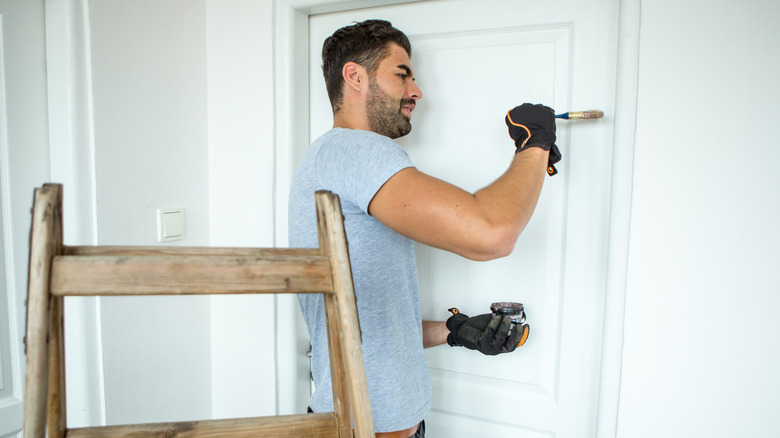How To Color Drench Your Doors The Right Way
If you've ever walked into a space and been completely enveloped in color, you have most likely experienced the magic of color drenching. It takes the concept of an accent wall and amplifies it, transforming your space into a monochromatic sanctuary. But the tricky part of this style isn't finding the right hue for your decor or even identifying the best areas in your house to try the color drench paint trend. It's actually tackling transition spaces like doorways and entryways that lead into a completely different color. The simple trick is painting the visible side of your door in the color of the room you're in, creating a seamless transition between colors. But it requires a bit more finesse than just painting to achieve that drowning-in-color feel. Here's a simple way to ensure the best color drenching results on your doors.
So, what exactly is the color drenching paint trend? Essentially, it's a design trend that requires only a single hue in your space. Everything matches in color, from the walls, doors, window trim, baseboards — everything in one signature shade. It's as if you dipped your whole room in a bucket of your favorite paint. Even something as simple as a light switch gets painted in your tone of choice. Color drenching can go so far as painting entire pieces of furniture in your color so they blend into the walls. But color drenching doesn't mean your space lacks visual stimulation — it's often accompanied by varying textures and materials to keep the space aesthetically appealing.
Perfecting color-drenched doors
The first step in color drenching your doors is understanding which side of the door gets which color. Put simply, the exposed side of the door should match the color of the room that it faces. Start with your door in the shut position, taking note of the sides that are currently exposed. You want to paint anything that can currently be seen to match the room, including the trim, door jamb, and the door itself. You can use a pencil or marker on each surface to avoid any costly painting mistakes some homeowners make. Repeat the same steps on the other side of the door, matching it to your alternate interior.
It can be a bit trickier to paint the door as it opens, but the result is truly worth it. Stand on the side of the door that pulls inward, as this will help with painting the side of the door. As you pull the door, you will come face-to-face with the skinny side of your door. You want to paint this small strip in the color of the room that you are standing in so that the color seems to curve around the door. The same applies to pushing the door inward and painting the small strip on the other side to match your other color choice. Additionally, door jambs should be painted only halfway for each color. The colors meet in the middle, creating that seamless transition while maintaining the nestled-in-color feel.
